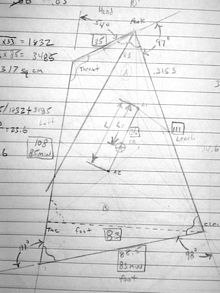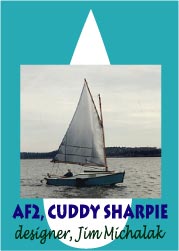| Part One - Part Two
Fitting the Perfect Sail - Part 2, Running the Numbers
Let’s get started and remember; don’t let the math scuttle you; have fun with it, embrace it, as you do the rest of your tools. Refer to the drawings as you read along.
 |
Refer to this drawing as you read along. |
1. You would be hard pressed to finish this process if you had no idea of the size your sail should attain. Because my project was designed with a 90 ft2 sail, that will be our goal for this exercise.
2. Find a sail design that makes you forget about human reproduction. Our example is a four sided sprit sail derived from a photo found on the Internet. It appears that the sail in the photo is larger than the one I intend to dimension, but that doesn't matter; all I want from the image is an outline.
3. Obtain a hard copy. A computer printer might help if your sail comes from an Internet source. An outline from a book picture might best be photo copied first while using the copier's enlargement feature if necessary. It was my experience that the internet photo was very small, so I copied the photo into a computer file, and then I used the computer's photo software to enlarge the image to a workable size. The longest dimension of the example is 111mm. Placing a sheet of paper over the computer screen, I lightly marked the four sail corners, using caution of course so as not to damage the computer. I then drew the head, leach, foot, and luff lines with the paper flat on a desk.
4. Using a metric ruler (a measuring system appropriate for this application), measure the dimensions of each side of the sail and write the values in millimeters (mm) adjacent to them. Then, use a small protractor to pick off the corner angles of the throat, peak, clew, and tac. Write down these angles, and then add them together; they should equal 360.
5. Choose one side of the sail for a standard. The standard should be a side that is least likely to alter in length should you decide to change the sail's design for aesthetic reasons or to accommodate rigging limitations. The side you pick will be a standard reference as we journey the meridian towards dimensioning. In the example, the leach line was the least likely to change for various reasons; the leach height and its angle to the head were for me a major aesthetic feature, and it is the longest line as well. The luff and foot lines were bound to change, and the head was just too short for the purpose. As you will see, the leach obtains a value of one, and all other line lengths will become a ratio. This trick allows us, in the end, room for dimensioning, quick calculations, and double checking of our math.
6. As we develop ratios, we tie all line dimensions to the standard. In this example, the leach is the standard line. The ratios permit us later to easily determine length in feet, yards, meters, or whatever system of measurement we choose.
Note: The lower original foot will not be included in these calculations. An additional dashed line in the drawing represents a foot modification that allows for a better fit on my boat.
Head/Leach = 35 / 111 = .3153
That wasn't difficult:
Luff/Leach = 85 / 111 = .7658 : 1
Foot/Leach = 83 / 111 = .7477 : 1
7. Next, we find the center of effort (CE) for our sail. Although finding CE in a square sail is over twice the work of that for a triangular sail, the math is still very simple and easily digested, as if it were a light fluffy pastry washed down with a cold glass of grog. The following is the triangle sail area formula:
Height (H) x Width (W) / 2 sail area
Caution: the width measurement must be perpendicular to the height line and not along the foot or head.
As we see in the example, a line is drawn from the clew to the throat. Two triangles of different size and dimension are created. We will call the upper triangle, A, and the lower triangle, B. You will also notice that within each of these triangles, three intersecting lines have been drawn to mark the CE of each (A1, A2). Take note that the three intersecting lines are drawn from each triangle corner to the center of the line opposite.
Now, draw line (L) between A1 and A2 and measure. Actual sail CE will lay along this line after each triangle is calculated for area:
Area of triangle A = 111 x 33 / 2 = 1832mm2
Area of triangle B = 85 x 82 / 2 = 3485mm2
A + B = total area
1832 + 3485 = 5317 mm2
With these sail area numbers and L, we evaluate for actual CE.
Actual CE = L1 = L x A2 / (A1 + A2)
Just plug in the numbers we already have:
L = 36
A1 = 1832
A2 = 3485
So:
L1 = 36 x 3485 / (1832+3485)
125460 / 5317
L1 = 23.6mm
Measure 23.6mm from A1 towards A2 and mark. This is the actual CE for this sail.
A few words:
I chose this sail because it will look great on my project, and it will be easy to sew. I’m pretty jazzed about it if you haven’t guessed. What remains is to dimension it for my boat, keeping in mind the target size of 90 ft2.
Because the sail derives its aesthetic appeal from angles and line lengths, I do not desire a cut that looks too different from the drawing. I can suffer the loss of the foot to enhance visibility, but otherwise, I want this sail on my boat as drawn.
Although the length of the leach line is our standard, we get at its actual dimension in feet through the aft hatch. Because I have a concern for the length of the luff line, given the mast height I intend to use, I want to make sure that the luff will not be too long - given the requirement to produce a sail of 90ft2.
Let’s get all our figures in one place:
Leach = 1
Head = .3153:1
Luff = .7658:1
Foot = .7477:1
Triangle A = 1832 1832 / 3485 = .5257 A:B = .5257:1
Triangle B = 3485
Target ft2 = 90 thus A + B must = 90
Or .5257 B + B = 90
And thus B (.5257 + 1) = 90
Which is the same as B x 1.5257 = 90
So
B x 1.5257 / 1.5257 = 90 / 1.5257
And to finish with a bang B = 58.99 ft2
We said that area A + B must equal 90, so A = 90 -58.99 = 31.01 ft
Now we determine the length of the luff to ensure it will fit my 12 foot mast. According to the dimensions of our drawing, the height of luff is 85, and the length of W is 82 (Note: W is not the same length as the foot). So 82 / 85 = .965:1 so W = .965H
Let's plug in some numbers to the formula that determines sail area, but only concern ourselves with triangle B.
Remember:
H x W / 2 = area
H x .965H / 2 = 58.99
H x .965H = 58.99 x 2
H^2 x .965 = 117.98
H^2 =117.98 / .965
H^2 = 122.26
H = sq root of 122.26
So H = 11.045ft = luff line
And W = 11.045 x .965 = 10.66 ft
So in turn Foot = 11.045 x .976 = 10.78 ft
Having a luff length that provides for a sail area of 90 ft2, and using our original ratios between the lines, we may now calculate the length of the lines around the sail in feet:
Luff = 11.045
The back door Leach = 11.045 x 1.306 (reciprocal of .7658) = 14.425ft
Head = .3153 x 14.425 (Leach) = 4.548ft
Foot = .7477 x 14.425 (Leach) = 10.786
Using these figures, and the corner angles previously measured, a cut to these dimensions would produce a sail very close to the targeted 90 ft2 figure.
Let’s double check:
Luff = .7658 x 14.425 (leach) = 11.047 That's close
A = 14.425 x 4.5 / 2 = 32.456
B = 11.045 x 10.66 / 2 = 58.87
32.456 + 58.87 = 91.326ft2
Very close to target area
We could tweak these figures - but why? By the time we shave some material from the leach and head during construction, we might measure a little less than 90ft2. Neither is interpreting the decimal feet all that critical; an inch variance will not make that much difference; 11.047 feet of luff nears 11' 9/16"; 14.425 feet of leach is very close to 14' 5"; and 10.786 feet of foot converts nicely to 10' 9 7/16", however, 10' 9" or 10' 10" might suit the purpose equally well.
How did I do that?
1" = 64/64 and thus 1' = 12" x 64, or 768/64.
So 768 x .786 = 604/64, 302/32, 151/16 …18.875/2, or 9.438 inches.
Convert the remaining decimal; 768 x .438 = 336/64, or 7/16.
10' 9 7/16" is extremely close to the 10.786' foot length.
I'll leave the head dimension unconverted for your practice.
HINT: there is a short-cut to this math!
I'm really very happy with the math and the dimensions it produced. The process gets easier every time I work it out, which shows me that I've learned something that profits the construction.
I believe the keys to the exercise are in the ratios between the lines and the ratios between triangles. With ratios, a designer could dimension this sail to any size and with any standard system of easurement. Remember also that the width measurement must be perpendicular to the height line, for if you use the foot or the head dimensions, the math is thrown off.
This whole boat-building project has been something of an education. I've already made major repairs to the bulwarks, yet the boat has never left the driveway. One fine afternoon, an irate neighbor in a fit of drunken stupor, who missed having an extra parking space, decided to punch holes in my boat with a hammer. A court order eventually pried repair money from his skinny wallet, and a notice from the land lord subsequently drove his family out of the complex and into other pastures.
What started as a balcony project on the third floor of an apartment complex has evolved over the past year into a sort of institution of higher learning. I've learned enough about wood, glue, screws, tools, and now sails to last a life time. Has it been fun? About 90% of the time. Frustrating? About 15%. Glorifying? 2%. Entertaining? 65%. Educational? Extremely. Expensive? A bit more than I expected. Satisfying? You bet. Would I do it again? Absolutely – given an option to build something different.
I looked upon this exercise much the same as I did when teaching myself celestial navigation; and why would anyone want to do that in this age of satellites and GPS? The answer is simple – it is a noble and ancient tradition steeped in history, adventure, discovery, and commerce; a craft which requires a certain combination of physical and mental energy and agility.
Sighting celestial objects with beautifully crafted and deceptively rugged instruments somehow gives meaning while attaching a tactile experience to the knowledge that we're not perfect and we don't know it all.
A sensual activity at times when the moon and stars flitter their pastel points upon glassy seas warmed by tropical latitudes and skimming naked feet, sighting may also humble the saltiest North Sea wayfarer when the clouds roll in and the ships roar - and when we are humble, we are teachable.
I know that when this sail you've helped me ponder fills with Western Pacific air, the dead air of humility I suffered at organizing its construction will spill, and this ancient and noble sail making tradition will have gathered another able body.
Good sailing to all.
|






